Developing JMP and VBA Add-Ins for Finite Mixture Modeling of Cotton Fiber Length Distribution
Abstract
Highlights
- This research developed custom software add-ins for data processing and statistical analysis of cotton fiber length distributions using the mixed Weibull distribution model.
- The add-ins were generated for JMP and MS Excel and are available to cotton researchers for use with data from the Advanced Fiber Information System (AFIS).
- Using the tools developed in this research, breeders, geneticists, and processors can effectively parameterize cotton fiber length distribution and extract the intrinsic and process-related factors shaping the distribution patterns.
- Breeders can use the tools to better discriminate between varieties based on intrinsic length, processors can optimize ginning and spinning to minimize fiber damage and to classify cottons based on length distribution parameters.
Abstract
1. Introduction
2. Methodology and Approach
- (1)
- Data cleaning and formatting
- (2)
- JMP Application Builder coding
- (3)
- Converting the JMP application into an installable JMP Add-In for distribution to users.
- (4)
- Validation
3. Results
3.1. AFIS Report Processing
3.2. JMP Length Distribution Analysis Application Development
3.3. Validation of Fit Results
3.4. JMP Fiber Length Distribution Analysis Add-In Compilation
4. Conclusions
- Develop tools for processing and analysis of length distribution data generated by current instrumentation: AFIS
- Develop statistical modeling tools for fiber trait distributions, as provided by AFIS testing.
Supplementary Materials
Author Contributions
Funding
Data Availability Statement
Conflicts of Interest
Abbreviations
| AFIS | Advanced Fiber Information System |
| HVI | High Volume Instrument |
| UHML | Upper Half Mean Length |
| LUI | Length Uniformity Index |
| JSL | JMP Scripting Language |
| VBA | Visual Basic for Applications |
References
- Thibodeaux, D.P. The impact of short fiber content on the quality of cotton ring spun yarn. J. Cotton Sci. 2008, 12, 368–377. [Google Scholar]
- Yang, S.; Gordon, S. Accurate prediction of cotton ring-spun yarn quality from high-volume instrument and mill processing data. Textile Res. J. 2017, 87, 1025–1039. [Google Scholar] [CrossRef]
- USDA. Cotton Classification: Understanding the Data; United States Department of Agriculture—Agricultural Marketing Service, Cotton Program: Memphis, TN, USA, 2018; p. 13. [Google Scholar]
- Bedez Üte, T.; Kadoğlu, H. A Statistical Model for Predicting Yarn Evenness of Cotton Sirospun Yarns. Eur. J. Eng. Nat. Sci. 2016, 1, 57–63. [Google Scholar]
- Krifa, M. Fiber Length Distribution in Cotton Processing: A Finite Mixture Distribution Model. Textile Res. J. 2008, 78, 688–698. [Google Scholar] [CrossRef]
- Cui, X.L.; Rodgers, J.; Cai, Y.Y.; Li, L.X.; Belmasrour, R.; Pang, S.S. Obtaining cotton fiber length distributions from the beard test method. Part 1: Theoretical distributions related to the beard method. J. Cotton Sci. 2009, 13, 265–273. [Google Scholar]
- Kelly, C.M.; Hequet, E.F.; Dever, J.K. Interpretation of AFIS and HVI Fiber Property Measurements in Breeding for Cotton Fiber Quality Improvement. J. Cotton Sci. 2012, 16, 1–16. [Google Scholar]
- Kelly, C.M.; Hequet, E.F.; Dever, J.K. Breeding for improved yarn quality: Modifying fiber length distribution. Ind. Crops Prod. 2013, 42, 386–396. [Google Scholar] [CrossRef]
- Constable, G.; Llewellyn, D.; Walford, S.A.; Clement, J.D. Cotton Breeding for Fiber Quality Improvement. In Industrial Crops: Breeding for BioEnergy and Bioproducts; Cruz, V.M.V., Dierig, D.A., Eds.; Springer: New York, NY, USA, 2015; pp. 191–232. [Google Scholar]
- Krifa, M. Fiber length distribution variability in cotton bale classification: Interactions among length, maturity and fineness. Textile Res. J. 2012, 82, 1244–1254. [Google Scholar] [CrossRef]
- Siddiqui, M.Q.; Wang, H.; Memon, H. Cotton Fiber Testing. In Cotton Science and Processing Technology: Gene, Ginning, Garment and Green Recycling; Wang, H., Memon, H., Eds.; Springer: Singapore, 2020; pp. 99–119. [Google Scholar]
- Armijo, C.B.; Delhom, C.D.; Whitelock, D.P.; Tumuluru, J.S.; Yeater, K.M.; Blake, C.D.; Rowe, C.; Wanjura, J.D.; Sui, R.; Holt, G.A.; et al. Evaluation of Alternative-Design Cotton Gin Lint Cleaning Machines on Fiber Length Uniformity Index. Agriengineering 2023, 5, 2123–2138. [Google Scholar] [CrossRef]
- Liu, Y.-H.; Zhang, M.; Sze, S.-H.; Smith, C.W.; Zhang, H.-B. Analysis of the genes controlling cotton fiber length reveals the molecular basis of plant breeding and the genetic potential of current cultivars for continued improvement. Plant Sci. 2022, 321, 111318. [Google Scholar] [CrossRef]
- Krifa, M. A Mixed Weibull Model for Size Reduction of Particulate and Fibrous Materials. Powder Technol. 2009, 194, 233–238. [Google Scholar] [CrossRef]
- Smith, C.W.; Braden, C.A.; Hequet, E.F. Generation Mean Analysis of Near-Long-Staple Fiber Length in TAM 94L-25 Upland Cotton. Crop Sci. 2009, 49, 1638–1646. [Google Scholar] [CrossRef]
- de Carvalho, L.P.; Farias, F.J.C.; Rodrigues, J.I.d.S. Selection for Increased Fiber Length in Cotton Progenies from Acala and Non-Acala Types. Crop Sci. 2015, 55, 985–991. [Google Scholar] [CrossRef]
- Cotton Incorporated. EFS® USCROP (TM); Cotton Incorporated: Carry, NC, USA, 2022. [Google Scholar]
- Herring, A.D.; Auld, D.L.; Ethridge, M.D.; Hequet, E.F.; Bechere, E.; Green, C.J.; Cantrell, R.G. Inheritance of fiber quality and lint yield in a chemically mutated population of cotton. Euphytica 2004, 136, 333–339. [Google Scholar] [CrossRef]
- Khan, A.; Kong, X.; Najeeb, U.; Zheng, J.; Tan, D.K.Y.; Akhtar, K.; Munsif, F.; Zhou, R. Planting Density Induced Changes in Cotton Biomass Yield, Fiber Quality, and Phosphorus Distribution under Beta Growth Model. Agronomy 2019, 9, 500. [Google Scholar] [CrossRef]
- Hinds, Z.; Kelly, B.R.; Hequet, E.F. Stability, variation, and application of AFIS fiber length distributions. J. Cotton Res. 2020, 3, 10. [Google Scholar] [CrossRef]
- Robert, K.Q.; Blanchard, L.J. Cotton Cleanability. Part I: Modeling Fiber Breakage. Textile Res. J. 1997, 67, 417–427. [Google Scholar] [CrossRef]
- Robert, K.Q.; Price, J.B.; Cui, X. Cotton Cleanability—Part II: Effect of Simple Random Breakage on Fiber Length Distribution. Textile Res. J. 2000, 70, 108–115. [Google Scholar] [CrossRef]
- Lin, Q.; Xing, M.; Oxenham, W.; Yu, C. Generation of cotton fiber length probability density function with length measures. J. Text. Inst. 2012, 103, 225–230. [Google Scholar] [CrossRef]
- Li, M.; Zhou, P.; Liu, Y.; Wang, H. Data-Driven Predictive Probability Density Function Control of Fiber Length Stochastic Distribution Shaping in Refining Process. IEEE Trans. Autom. Sci. Eng. 2020, 17, 633–645. [Google Scholar] [CrossRef]
- Kuang, X.; Hu, Y.; Yang, J.; Yu, C. Application of finite mixture model in cotton fiber length probability distribution. J. Text. Inst. 2014, 106, 146–151. [Google Scholar] [CrossRef]
- Kuang, X.; Yu, C. Generating cotton fiber length probability density function from fiber length parameters by finite mixture model. J. Text. Inst. 2014, 106, 655–662. [Google Scholar] [CrossRef]
- Kuang, X.; Hu, Y.; Yu, C. The theoretical yarn unevenness of cotton considering the joint influence of fiber length distribution and fiber fineness. Textile Res. J. 2015, 86, 138–144. [Google Scholar] [CrossRef]
- Krifa, M. Cotton fiber length distribution modality alteration in ginning and mill processing. J. Text. Inst. 2013, 104, 731–744. [Google Scholar] [CrossRef]
- Saunders, S.; Webb, J. Programming Excel with VBA and .NET; O’Reilly: Sebastopol, CA, USA, 2006. [Google Scholar]
- Walkenbach, J. Excel 2010 Power Programming with VBA; Wiley Pub.: Hoboken, NJ, USA, 2010. [Google Scholar]
- Utlaut, T.L. JSL Companion: Applications of the JMP Scripting Language, 2nd ed.; SAS Institute: Cary, NC, USA, 2018. [Google Scholar]
- McCormack, D., Jr. Making Exploration of Nonlinear Models Fast and Easy Using JMP® 10. In Proceedings of the SAS Global Forum, Orlando, FL, USA, 22–25 April 2012. [Google Scholar]
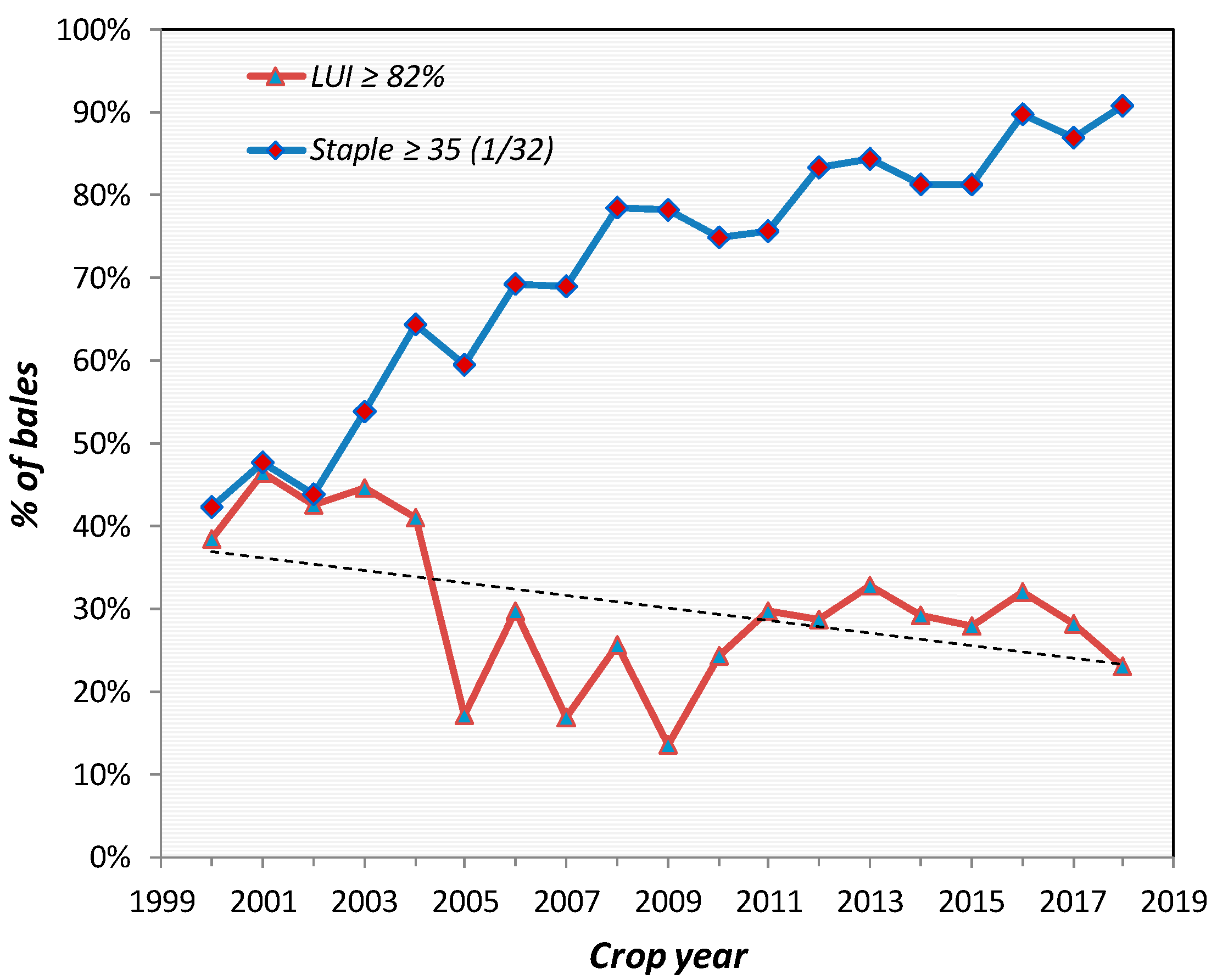

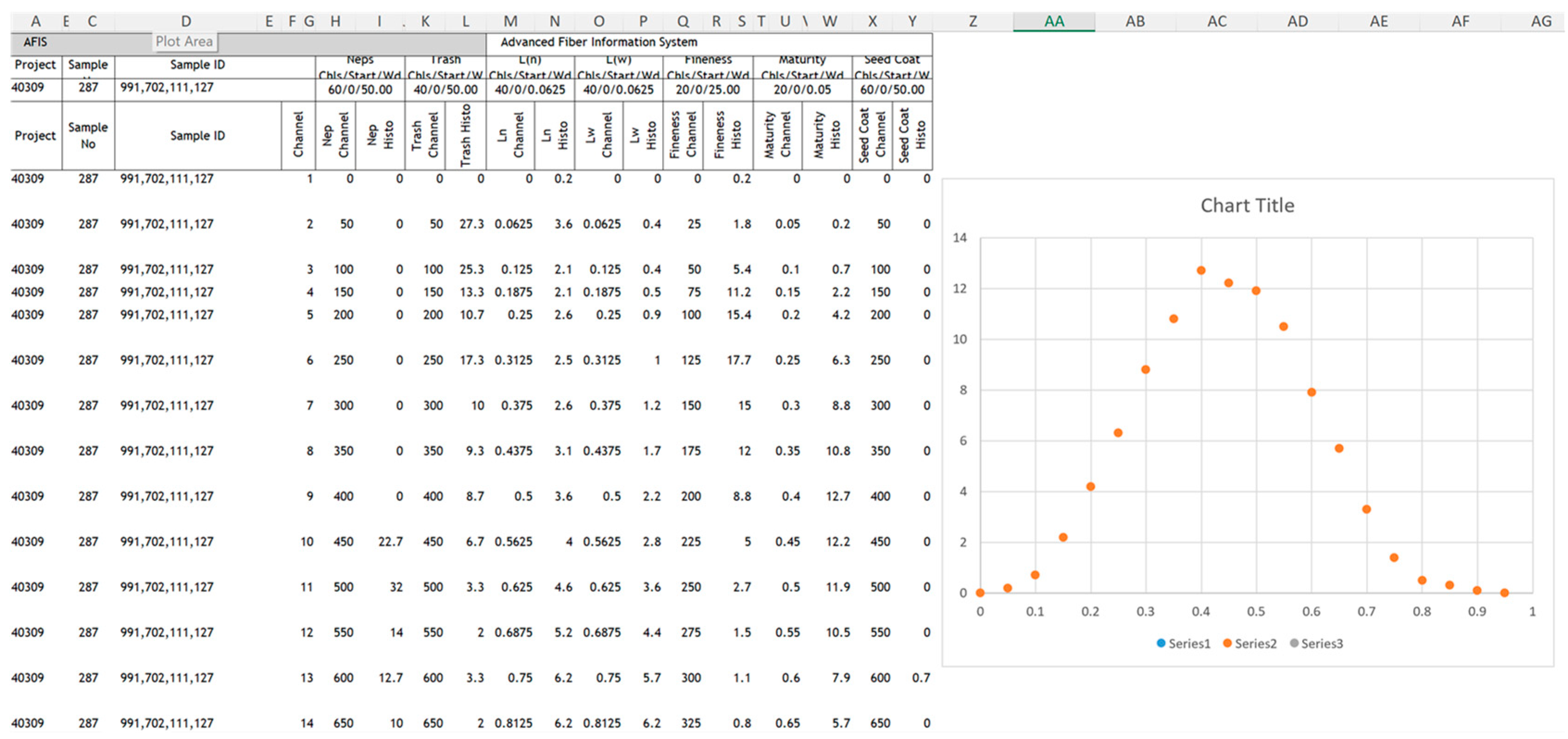

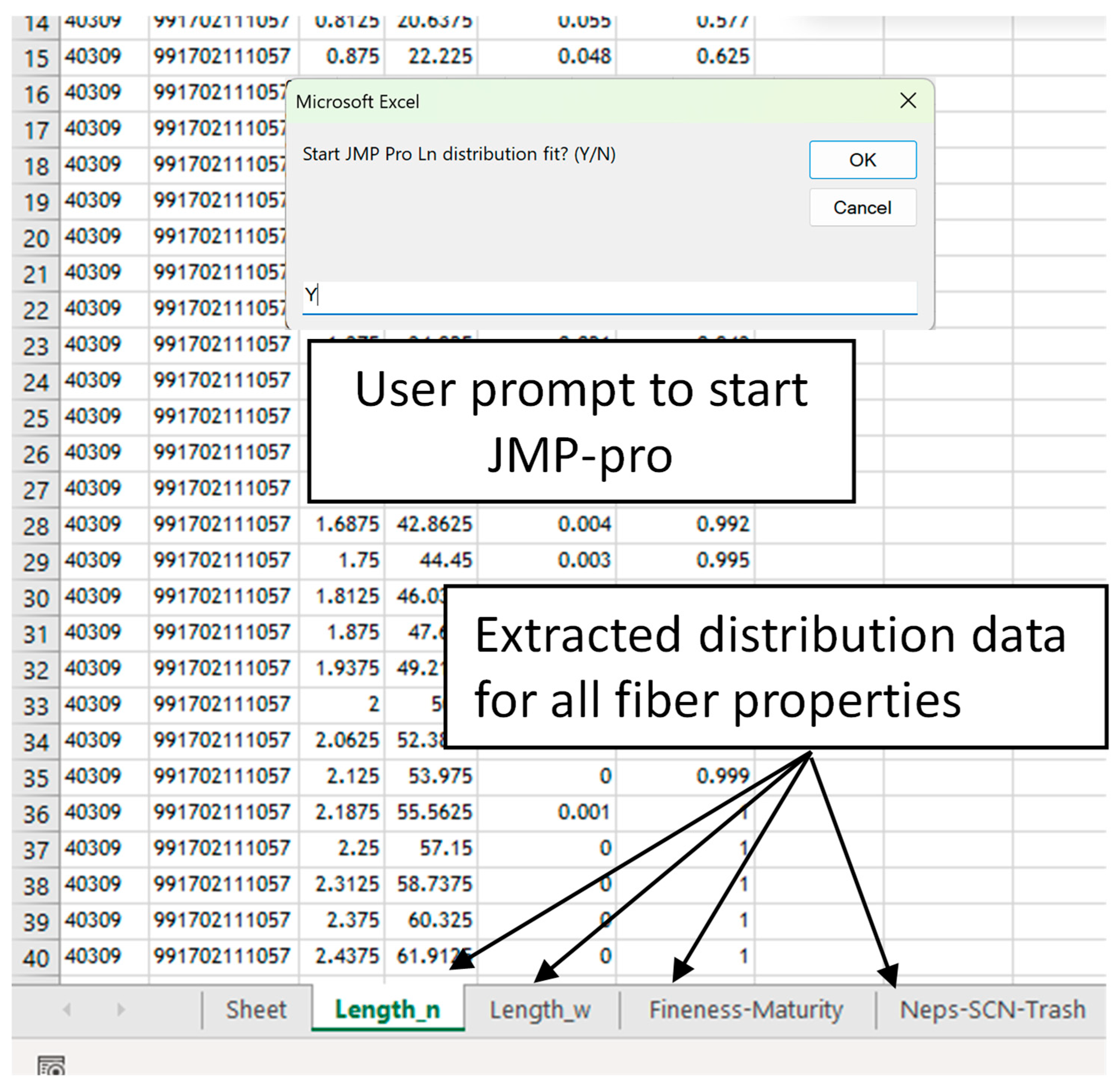

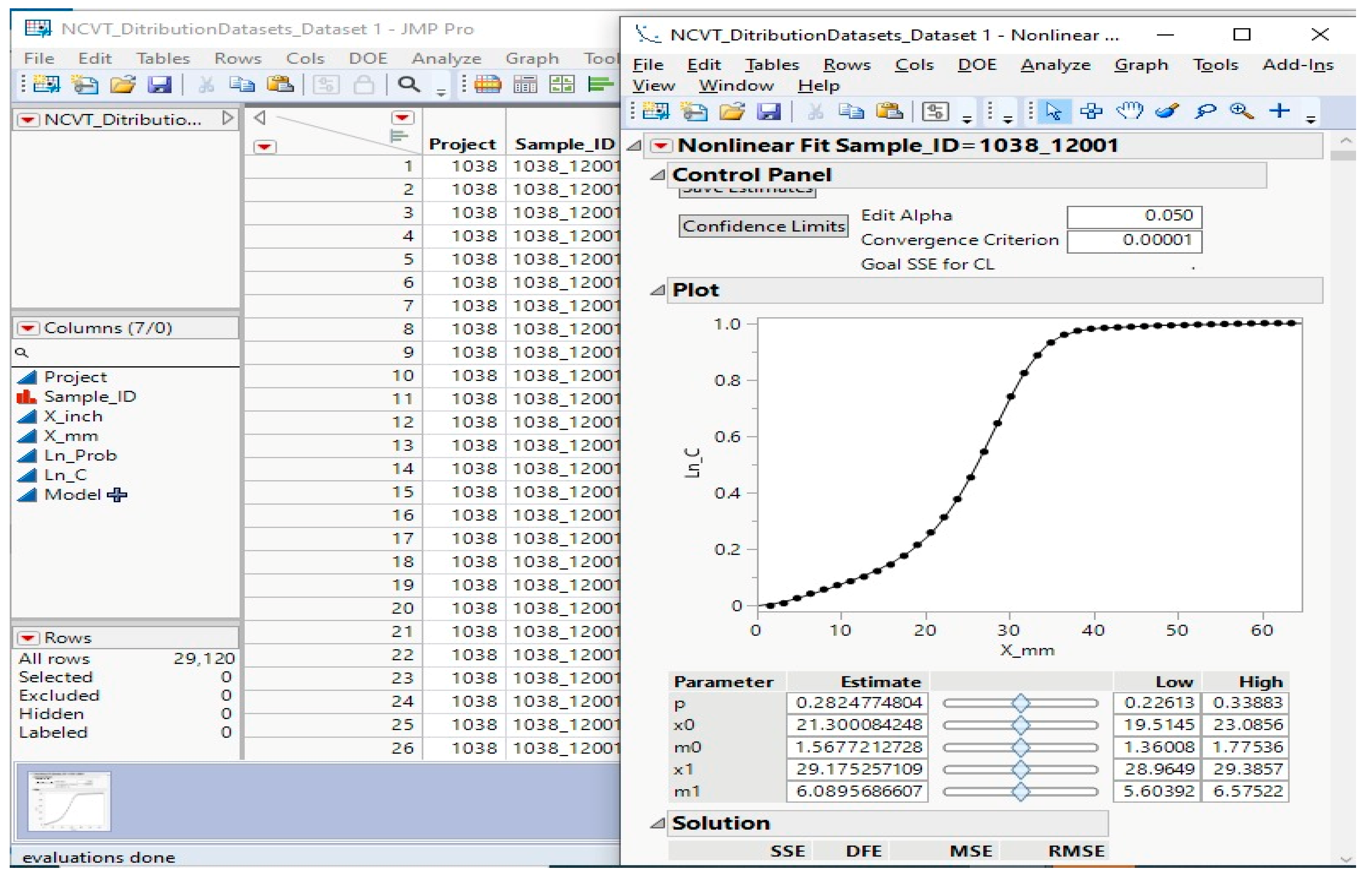
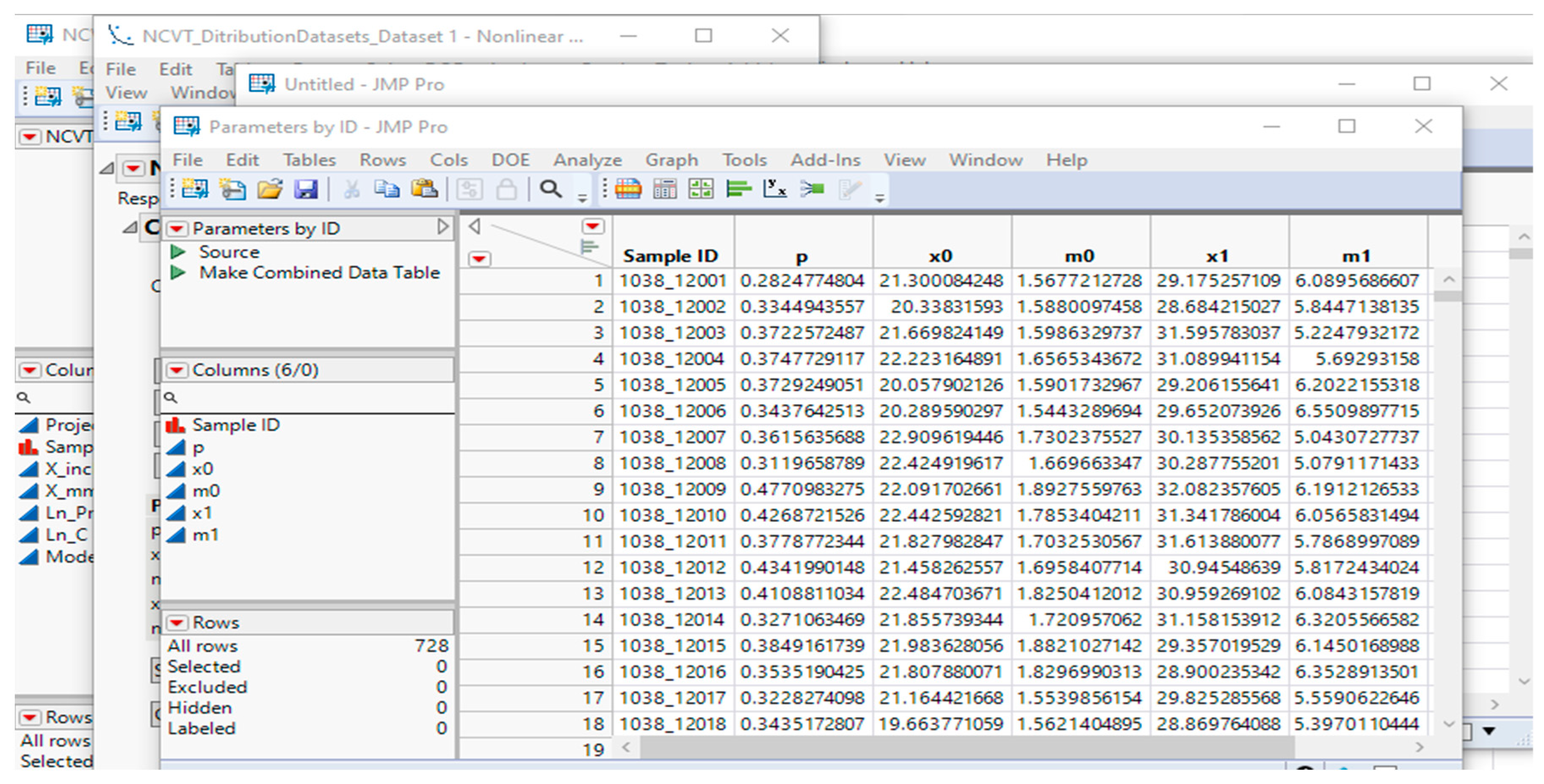
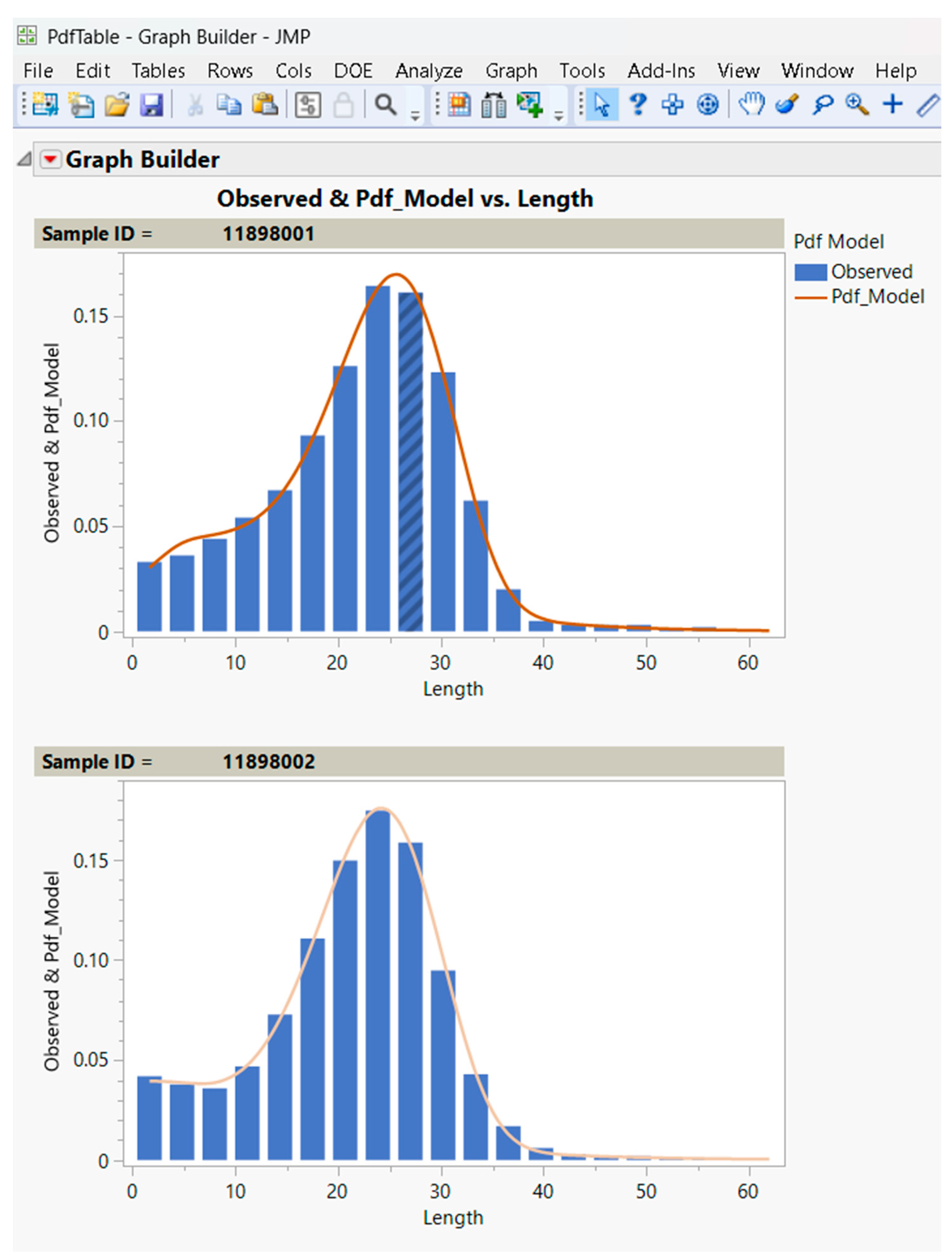

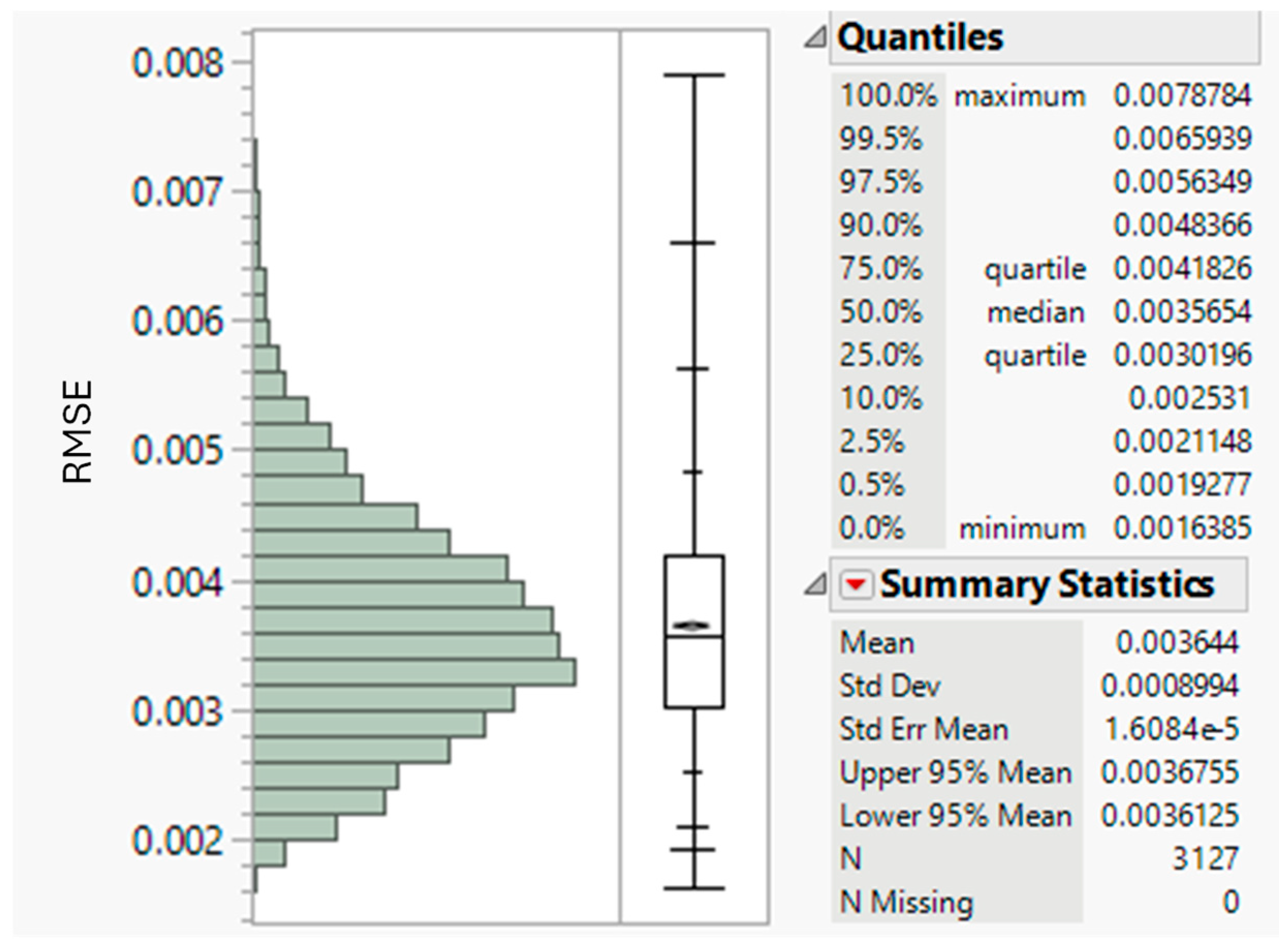
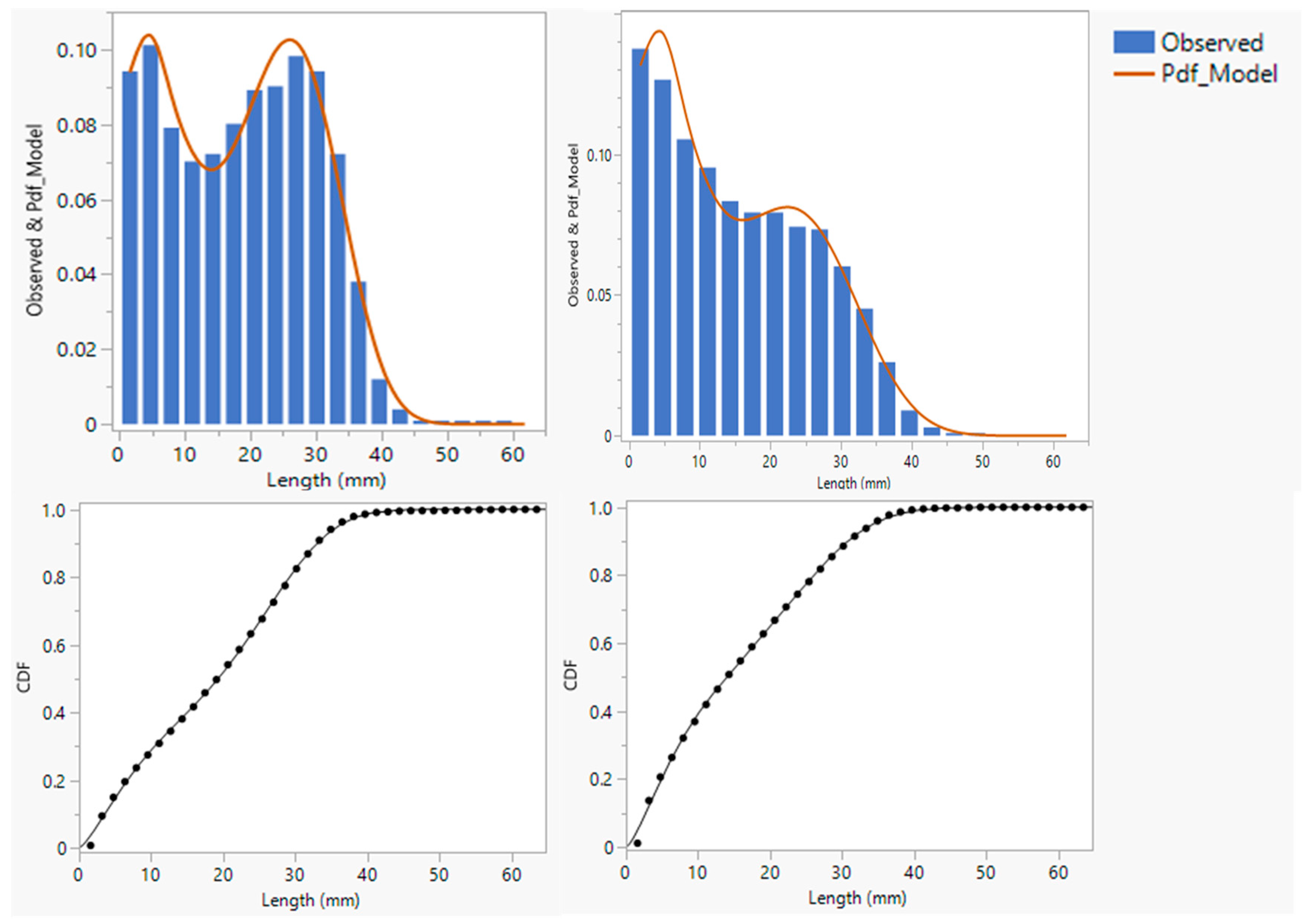
Disclaimer/Publisher’s Note: The statements, opinions and data contained in all publications are solely those of the individual author(s) and contributor(s) and not of MDPI and/or the editor(s). MDPI and/or the editor(s) disclaim responsibility for any injury to people or property resulting from any ideas, methods, instructions or products referred to in the content. |
© 2025 by the authors. Licensee MDPI, Basel, Switzerland. This article is an open access article distributed under the terms and conditions of the Creative Commons Attribution (CC BY) license (https://creativecommons.org/licenses/by/4.0/).
Share and Cite
Krifa, M.; Garlapati, V.; Martin, V.B.; Kothari, N. Developing JMP and VBA Add-Ins for Finite Mixture Modeling of Cotton Fiber Length Distribution. Fibers 2025, 13, 91. https://doi.org/10.3390/fib13070091
Krifa M, Garlapati V, Martin VB, Kothari N. Developing JMP and VBA Add-Ins for Finite Mixture Modeling of Cotton Fiber Length Distribution. Fibers. 2025; 13(7):91. https://doi.org/10.3390/fib13070091
Chicago/Turabian StyleKrifa, Mourad, Vinusha Garlapati, Vikki B. Martin, and Neha Kothari. 2025. "Developing JMP and VBA Add-Ins for Finite Mixture Modeling of Cotton Fiber Length Distribution" Fibers 13, no. 7: 91. https://doi.org/10.3390/fib13070091
APA StyleKrifa, M., Garlapati, V., Martin, V. B., & Kothari, N. (2025). Developing JMP and VBA Add-Ins for Finite Mixture Modeling of Cotton Fiber Length Distribution. Fibers, 13(7), 91. https://doi.org/10.3390/fib13070091





